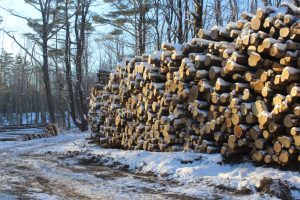SFR 510 – FOREST OPERATIONS FINANCE
| Online Course: SFR 510 – FOREST OPERATIONS FINANCE
An introduction to the business of forestry for professional foresters The class has been approved for 42 Category 1 Continuing Forestry Education (CFE) credits by the Society of American Foresters. Classes begin September 3. All material is online and follows a weekly schedule. Students are expected to participate in an online discussion session on Tuesdays, 7 to 8:50 pm (eastern time). Last day of the semester is December 13, 2024. |
 |
TO REGISTER FOR FALL 2024 GO TO:
https://online.umaine.edu/how-to-register-for-courses/
If you are not in a UMaine degree or certificate program, register as a non-degree student.
Course Description:
SFR 510 – Forest Operations Finance. This course will provide a basic understanding of financial issues found in timber-management organizations or in individual consulting businesses. Students will explore the basic steps in preparing to harvest timber, from estimating volumes on the harvest block to costing out roads necessary to move the forest products. Steps for financing the operation include negotiating stumpage rates and evaluating markets. 3 cr. Prerequisites: SFR 401 – Timber Harvesting and SFR 444- Forest Resource Economics, or graduate standing, that is, have earned a bachelor’s degree. If you are not in a UMaine degree or certificate program, register as a non-degree student.
Instructors
| Ted Shina, Licensed Maine Forester – Phone: 207.745.8186 – email: theodore.shina@maine.edu |  |
| Dr. Anil Kizha, Associate Professor of Forest Operations, School of Forest Resources, 207.581.2851, anil.kizha@maine.edu |  |
Student Learning Outcomes:
- Students will be able to describe the current framework of the business of forest operations in Maine, from the stump to the mill,
- Students will be able to quickly estimate volumes by forest products, with their respective market values, so that they can prepare a proposal or harvest plan, along with the full financial impact to the landowner, the logging contractor, and the land management company or consultant in a timely manner.
- Students will be able to accurately forecast revenues, road costs, harvesting costs, and potential net revenues for landowners and timber management companies. A class project will start with a woodlot harvesting scenario, then develop an operational plan/budget to present as a proposal to the landowner.
Class Schedule – A Draft
| Week | Topics & Assignments |
| 1 | Introductions, Course Objectives, Syllabus. History of Stumpage in Maine for standing timber, lump sum payments, by forest products, etc. Video: From Stump to Ship – Basic elements of a harvest operation – in the 1930’s. Describe costs deduced from the film. |
| 2
|
Harvest Planning Checklist. Elements of the Harvest Plan. Methods of estimating harvest volumes and products for a harvest operation in an expedited time schedule. Estimating layout costs, boundary line maintenance costs, etc. |
| 3
|
What is a budget? Explore a sample budget. Budget forecasts – by fiscal year, quarter, month. Weekly production forecasts. Guest Speaker – Chris Washburn, Director of Finance, Huber Resources Corporation. Accounting for foresters, including Depletion and Cost accruals. |
| 4
|
Access. Estimating road construction/maintenance costs. Determining logging season (winter vs. summer). “Costing out a road” Road Use Agreements with adjacent landowners (if necessary). Estimating costs for necessary bridges and other water crossings. Road tolls. |
| 5
|
Cost of complying with environmental regulations. Permitting and compliance costs. Permit-By-Rule vs. mandated permit preparation (example: bridge over river or CAT III Clearcut). Time constraints. |
| 6
|
Trucking costs. Road tolls. DOT regulations, truck weight limits, posted roads – cost implications. Wheelers vs. Tree-length vs. Center mounted loaders on tractor-trailers. Diesel rates. Fuel cost adjustments mid-contract. Adverse grade rate adjustments. Zone prices for long-hauls. Turns per day requirements per truck. (trips to the mill). |
| 7 | Markets for forest products in Maine. Pulp and paper mills, sawmills, specialty products. Analyzing the feasibility of markets for a specific area. Using a broker vs. Mill Sale Agreements. Gate prices vs supply agreements). |
| 8 | Management Agreements: percentage of net revenue vs. acreage fee/year. Stumpage permits. Discussion of forestry services agreements, forest inventory, surveying, mapping, etc. |
| 9 | Financial impacts of a partial harvest vs a clearcut or overstory removal. Landowner Objectives/strategies. Future value and product adjustments in a partial harvest. Net Present Value of a timber asset by management strategy. Return on Investment. Mill Revenue minus Harvest Costs equals Net Revenue (from operations). |
| 10 | Contract negotiations with logging contractors. Types of logging contracts, such as stumpage permits/timber sale agreements, service contracts, trucking only contracts. etc. Contract administration. Trip tickets, scale slips, communication with admin. staff. Guest Speaker: Reona Cole, administration specialist Huber Resources Corporation |
| 11 | Presentation of woodlot, scenario for class project. |
| 12 | Elements of logging costs for the harvest operation. Contractor’s costs, including insurance, parts/maintenance, labor, financing new equipment. Feller-bunchers vs. Processors vs. hand crews – costs/production rates. |
| 13 | Discussion of preparing a budget/proposal for the landowner. Stumpage vs long term management agreements. Guest Speaker: Jon Kelley, Sr. Operations Forester, Huber Resources Corporation. Discuss client communications/relations, forecasts, expectations. |
| 14 | Presentation of class project. Summary of principles. |
TO REGISTER FOR FALL 2024, BEGINNING SEPTEMBER 3, GO TO:
https://online.umaine.edu/how-to-register-for-courses/
If you are not in a UMaine degree or certificate program, register as a non-degree student.

